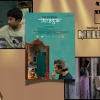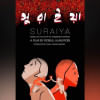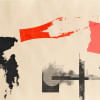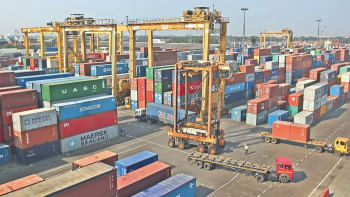When cinema reflects a nation’s unsettled soul

The birth of a nation, particularly one forged in the crucible of war, often necessitates a foundational narrative—a simplified, heroic account that binds a disparate populace. For Bangladesh, that narrative is inextricably linked to its bloody liberation from Pakistan in 1971. Yet, as the decades have passed, the once-unquestionable contours of this origin story have softened, blurred and, at times, been fiercely contested.
Perhaps like other war histories, our tumultuously toxic debate over our own past, including its many revisions, has been recounted in numerous books and literary works, particularly in Bangla. A range of authors, including those who fought in the Liberation War, contributed to it. In fact, this arduous, maybe even unresolvable, and certainly unfinished debate over our political history has shaped the nation's pernicious political journey in many ways. It reached another crimson crescendo merely 12 months ago.
But this piece is not about those debates. Rather, it reflects on a rare lens through which to view our war history: cinema, more specifically, through an essay by film-maker and researcher Naeem Mohaiemen. In a recent long-form essay for the academic journal BioScope: South Asian Screen Studies, titled "A Looking Glass War: Bangladesh's Pendulum-swing Liberation War Cinema," Mohaiemen examines two films on the Liberation War, created 40 years apart. The essay highlights our societal understanding, shifting evaluations, and public responses.
Why does this matter, especially as a new generation of political leaders and power brokers prepare to assert their own versions of history? George Orwell's timeless warning from 1949 still resonates, "Who controls the past controls the future: who controls the present controls the past."
For my generation, growing up during the 1980s under the Ershad regime, local cinema largely failed to appeal to the urban middle class, who turned to Bollywood instead. Bangladeshi films primarily catered to rural and labouring audiences, offering a brief respite from daily hardship. Yet, Mohaiemen's essay reveals that our cinema has served as far more than mere entertainment. It has been a remarkably sensitive barometer of the nation's shifting self-perception, charting what he calls a "pendulum swing" in national identity that oscillates between secular, linguistic aspirations and a complex, resurgent religious piety.
Mohaiemen's astute reflections on Bangladeshi war films offer a compelling lens through which to examine this deep, often painful, negotiation of history, memory, and the very soul of a people. It is no surprise that Mohaiemen, who explored the idea of "correct history" in a 2014 book and through numerous essays over the years, would return once again to re-examine the past, this time through the lens of our Liberation War films, comparing them with post-1947 cinematic treatments in India and Pakistan.
In his characteristic diligence and style, Mohaiemen delves deeply into a subject that may have been explored before, including by other South Asian scholars, but rarely through our own big screens. He references films and artworks that many ordinary people, myself included, may not have seen but can now discover.
Naeem Mohaiemen's cinematic pendulum
In the immediate aftermath of independence, the newly sovereign Bangladeshi state embarked on a state-sponsored cultural endeavour, crucial for consolidating national identity, and found a powerful ally in cinema. Films from this era, such as Chashi Nazrul Islam's remarkably swift 1972 release Ora Egaro Jon (They Are Eleven), served as artistic tools of ideological reinforcement.
The narrative was clear: the Pakistani military and their local collaborators, the rajakars, were unequivocally evil. Their depravity was often underscored by a caricatured depiction of piety. Characters adorned with prayer caps and pious exclamations became visual shorthand for treachery, their faith inextricably linked to forces seen as "primitive, anti-modern, annihilating, and anti-nationalist."
This cinematic framing served an explicit political purpose. By associating religious conservatism with the enemy, the post-war state sought to cement secular, linguistic nationalism as the bedrock of Bangladeshi identity. The events leading to the 1947 Partition, when Bangalee Muslims had championed a separate homeland based on shared faith, were quietly erased or sidelined.
The two decades of East Pakistan's existence, in which Bangalee Muslims struggled for recognition within a broader "Pakistani" framework, were omitted from these simplified cinematic retellings. Instead, the Bangla language emerged as the singular authentic marker of national belonging. Political actors of the time might argue that such simplification was necessary for a fledgling nation attempting to define itself in opposition to a traumatic past. But this narrative inevitably papered over deeper and more complex social undercurrents.
Women's portrayals in these early war films conformed to rigid, problematic templates. The Biranganas, brave women who endured sexual violence during the war, were valorised in state rhetoric, yet cinematically reduced to two archetypes: the endangered victim or the tragic martyr. In Ora Egaro Jon, scenes of sexual assault, while intended to shock, occasionally edged towards a voyeuristic gaze, reducing these women to their suffering.
The cinema, in such instances, reflected a society's discomfort with the moral injuries inflicted upon women to fully integrate their experiences into a triumphant national narrative without imposing a patriarchal resolution. While the war may have liberated the nation, its women were often left doubly shackled—first by violence, then by stigma.
A new millennium, a shifting lens
As Bangladesh entered the 21st century, a discernible shift occurred. The once-inviolable secular narrative began to fray—challenged by a global Islamist resurgence, waves of conservative rule at home, and an increasingly complex internal debate about national character. These ideological shifts inevitably found expression on screen.
In 2011, Rubaiyat Hossain's Meherjaan became a cinematic lightning rod, sparking fierce public debate and leading to its rapid removal from big screens. Its central premise, a consensual romance between a Bangalee woman and a Pakistani soldier, was an unthinkable betrayal of the national narrative, at least for many. Yet, as Mohaiemen compellingly argues, this controversial storyline was also a vehicle for a deeper re-evaluation of women's honour and agency in the aftermath of wartime violence.
Neela, one of Meherjaan's protagonists and a rape survivor, stands in sharp contrast to her cinematic forebears. She does not succumb to suicide or silence. Instead, she refuses shame and actively seeks retribution, even joining female guerrillas. This shift was not spontaneous artistic invention but the product of decades of tireless feminist organising in Bangladesh—a slow but persistent dismantling of the patriarchal assumptions that long shaped how women's trauma was narrated.
The film captured a growing societal maturity, a readiness to see women not just as victims but as agents of resistance, with their own voices and choices. It signalled a society inching towards a more honest reckoning with the psychological and social aftermath of war, moving beyond binary portrayals of victimhood and valour.
Unresolved contradictions
The cinematic pendulum is not purely artistic, it reflects broader political and economic shifts. While early war films were often state-funded and ideologically guided, later productions like Meherjaan came from more independent, sometimes internationally oriented, creative spaces. Yet, even with increased public and private support for war films in recent decades, core contradictions remain unresolved: the role of religion in public life, the complexities of female experience in conflict, and the limits of acceptable narrative.
Bangladesh's progress since its birth, especially economically, is impressive. Yet, its path has also been marked by persistent debates over its foundational principles. As Mohaiemen's essay shows, the cinematic lens offers a uniquely intimate view into this ongoing struggle. It reveals a country that, while fiercely proud of its liberation, is still grappling with the full spectrum of its identity, shifting from simplified heroes and villains towards a more complex—at times uncomfortable—reckoning with the diverse forces that shaped its past and continue to define its present.
As the nation continues to evolve, so too will its cinema. It will remain a contradictory and contested "looking glass," reflecting the evolving contours of a nation still finding its true self, perpetually caught in the oscillation between memory, identity, and the relentless march of the contemporary.
Irfan Chowdhury is a public sector policy analyst and adviser.
Views expressed in this article are the author's own.
Follow The Daily Star Opinion on Facebook for the latest opinions, commentaries and analyses by experts and professionals. To contribute your article or letter to The Daily Star Opinion, see our guidelines for submission.

 For all latest news, follow The Daily Star's Google News channel.
For all latest news, follow The Daily Star's Google News channel. 










Comments